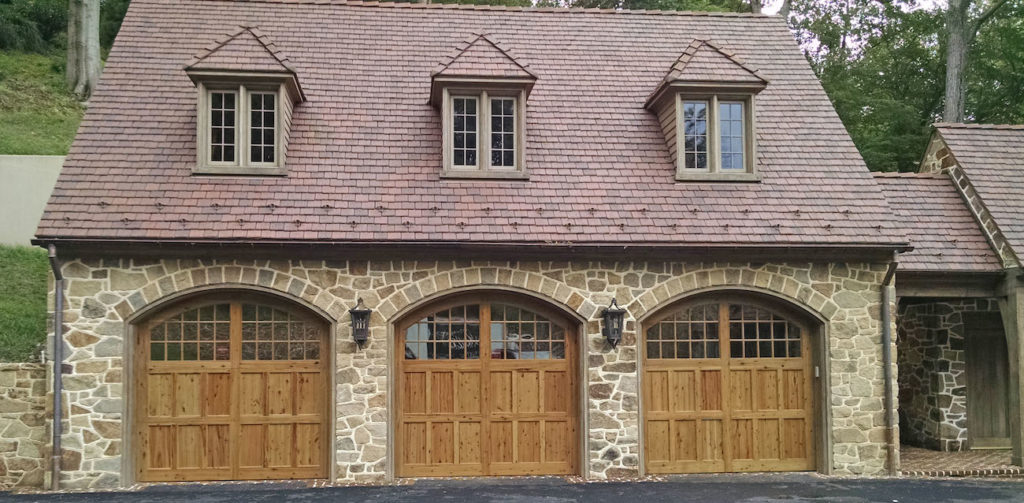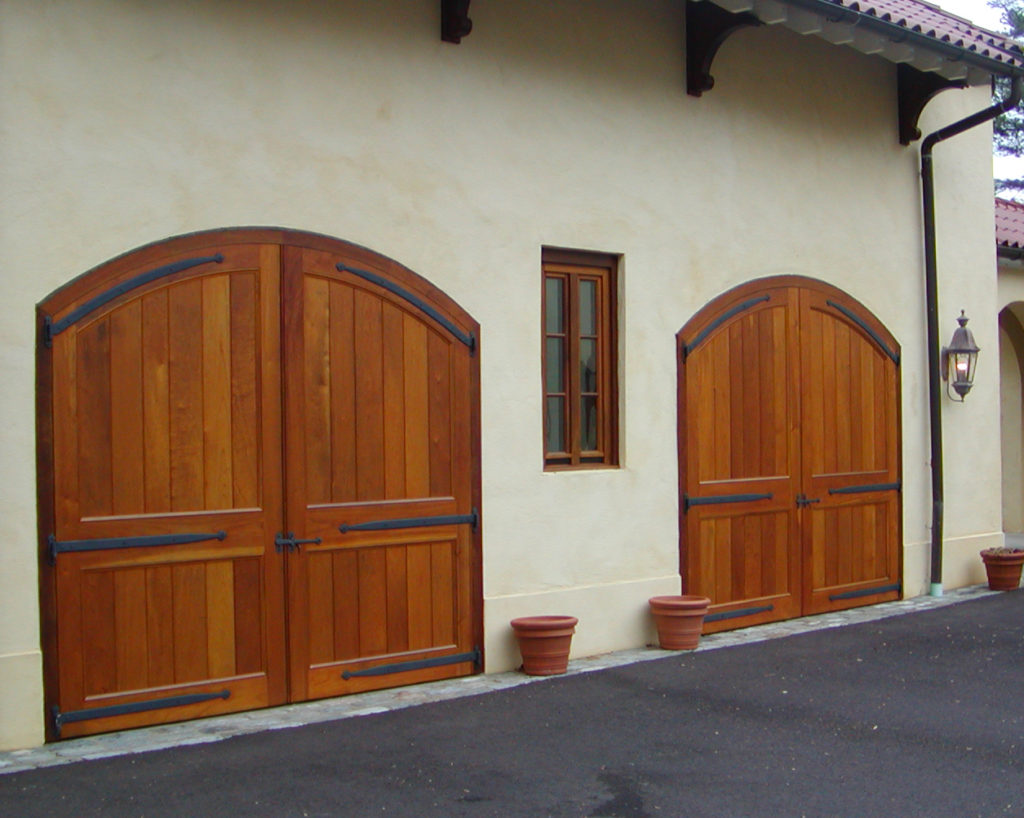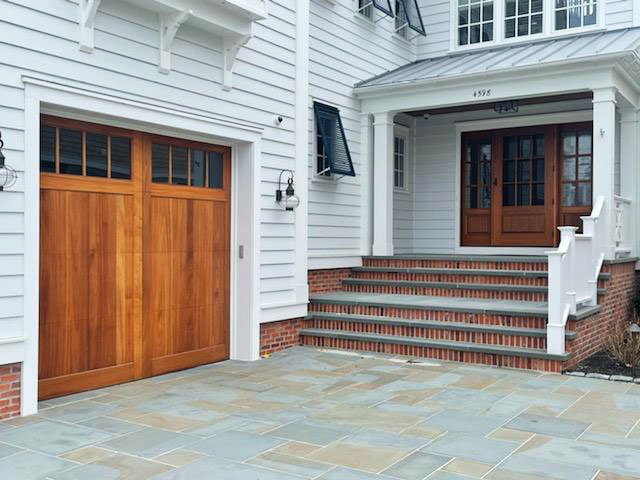Wooden garage doors are a sophisticated addition to homes of every shape, size, and style. There’s a lot to consider before choosing a wooden garage door, though. If you’re interested in purchasing one of these doors for your home, this buying guide is for you. Our wood garage door buyer’s guide features everything you need to know, from wood species and add-ons to costs and maintenance. We’ll start with an overview of the pros and cons of wooden garage doors.
Why Choose a Wood Garage Door?
There are lots of reasons to purchase a wooden garage door for your home. Here are a few of the most compelling reasons:
- Wooden garage doors offer outstanding curb appeal and add sophistication and beauty to your home’s exterior.
- They’re available in a wide variety of shapes and sizes and are easy to customize.
- You can choose from a variety of wood species and finishes to make your door your own.
- Wooden garage doors are very effective at insulating your garage from the elements.
What Are the Downsides of Wood Garage Doors?
While there are plenty of reasons to choose a wooden garage door, they aren’t right for every home. Here are some reasons why wooden garage doors might not be your best option:
- Wooden garage doors require more maintenance than doors with vinyl or composite material. We’ll talk more about this below.
- Wood is less durable than other materials because it expands and contracts and can warp and crack as it weathers.
- Wooden doors are very heavy, which can wear out garage door openers more quickly.
- These doors can be very expensive depending on factors like design and wood species.

Which Wood Species Are Available?
Wooden garage doors can be constructed from a variety of different wood species. We’ve described a few of the most popular below:
Red Grandis
- Origin: Coastal Australia
- Grain Pattern/Texture: This species has a moderately coarse grain pattern that’s predominantly straight or somewhat interlocked.
- Color: Red grandis is relatively uniform in color and varies from pale to medium pink.
- Other Traits: This species is a versatile, fast-growing hardwood from the eucalyptus family. It’s stable, ideal for exterior applications, and holds paint well.
Sapele Mahogany
- Origin: Tropical Africa
- Grain Pattern/Texture: This species has a straight or shallowly interlocked grain with medium texture and moderate luster.
- Color: Spanish cedar is usually light-pinkish to reddish-brown, but tends to darken with age. Pockets of gum and natural oils are often present.
- Other Traits: This strong hardwood has a soft to medium density that’s great for exterior use. It can also withstand decay and termites and has outstanding weathering characteristics.
Spanish Cedar
- Origin: Central America, South America, and the Caribbean
- Grain Pattern/Texture: This species has a straight or shallowly interlocked grain with medium texture and moderate luster.
- Color: Spanish cedar is usually light-pinkish to reddish-brown, but tends to darken with age. Pockets of gum and natural oils are often present.
- Other Traits: This strong hardwood has a soft to medium density that’s great for exterior use. It can also withstand decay and termites and has outstanding weathering characteristics.
Western Red Cedar
- Origin: Western North America
- Grain Pattern/Texture: This species has a tight, straight grain with few knots.
- Color: Western red cedar ranges from light straw to reddish- or pinkish-brown with random streaks of darker red and brown areas in the heartwood.
- Other Traits: This species is flexible and strong. It’s also naturally resistant to decay, seasons quickly, is pitch-free, and isn’t prone to shrinking.
Douglas Fir
- Origin: Western North America
- Grain Pattern/Texture: This species has a straight or slightly wavy grain with a medium to coarse texture and moderate natural luster.
- Color: Douglas fir is usually a light brown color with hints of red and yellow with darker growth rings.
- Other Traits: This species is strong, stiff, and durable and works well with a variety of stains and finishes.
Which Finish Options Are Available for Wood Garage Doors?
Wooden doors can be stained or painted and come in both stain-grade and paint-grade. Stain-grade doors use wood species that will look beautiful when stained or painted. Paint-grade doors use stain-quality woods suitable only for paint finishes.
You can choose from the following finish options:
- Prime Only
- Paint
- Faux Stain
- Stain
Keep in mind that darker paint and stain colors tend to fade faster than lighter colors, especially if they’re in direct sunlight. That means they require more maintenance over time.

Which Wood Garage Door Add-Ons Are Available?
You can deck out your wooden garage door with a variety of attractive, easy-to-install accessories, including the following:
Decorative Hardware
Clavos
These unique add-ons are perfect for your door’s trim or paneling.
Custom Wood Jambs & Casings
These sophisticated add-ons help your door stand out and enhance curb appeal.
Door Stops with Weather Seals
Every Artisan door comes standard with door stops and weather seals for superior insulation.
Latches
These products enhance the classic look of carriage house style doors.
Pull Handles & Rings
These add-ons come in several styles to fit any garage door.
Specialty Glass
We can provide any kind of specialty glass you want to give your door a one-of-a-kind look.
Strap Hinges
These products add a rustic look and are perfect for carriage house style doors.
What Are the Best Climates for Wooden Garage Doors?
Wooden garage doors work best in locations with moderate temperatures and low to moderate moisture. They aren’t a good choice for coastal areas or regions prone to extreme weather (like hurricanes).
How Do You Maintain a Wood Garage Door?
Exposure to sun, wind, and water negatively impacts wooden garage doors, so they’re considered medium to high maintenance.
The elements will break down your wooden garage door’s top coat over time. If you don’t refresh it periodically, the top coat can be destroyed quickly. Annually refreshing the top coat helps prevent more significant maintenance down the road.
Use a mild detergent and a soft cloth or bristle brush to clean your wooden garage door. Then, rinse it with a garden hose or low-pressure garden sprayer. You should never use a pressure washer to rinse off your wooden garage door.



